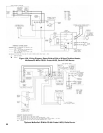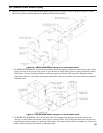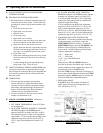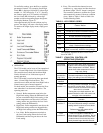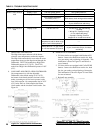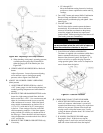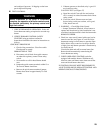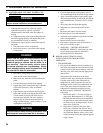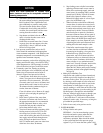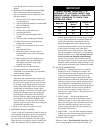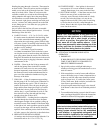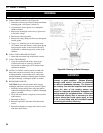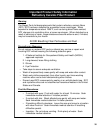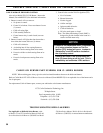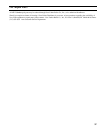
30
V. Maintenance and Service Instructions
A. MAINTENANCE OF LOW WATER CUT-
OFF DEVICES
WARNING
Probe and oat type low water cut-off devices
require annual inspection and maintenance.
1. Although these devices are solid state in their
operation, the probe is exposed to possible
contamination in the boiler water and subject to
fouling.
2.
It is important to physically remove the probe from
the boiler tapping annually and inspect that probe
for accumulation of scale or sediment.
3. Follow these steps to inspect, clean and/or replace
the probe:
a. Turn off electric service to the boiler.
b. Drain boiler water to a level below the tapping
for the probe.
DANGER
Assure that the boiler is at zero pressure before
removing the LWCO probe. Do not rely on the
pressure gauge to indicate that the boiler is at
zero pressure. Open the safety valve to relieve
all internal pressure prior to proceeding. Safety
valve discharge piping must be piped such that
the potential for burns is eliminated.
c. Disconnect wiring connections between the low
water cut-off control and the probe.
d.
Remove the low water cut-off control from the
probe.
e. Unscrew the probe from the boiler tapping.
f. Inspect that portion of the probe that is exposed
to the boiler water for a scale or sediment
buildup.
g. Light deposits may be removed by wiping the
probe with a damp cloth. Wiping the probe with
a cloth soaked in vinegar will remove more
tenacious lime deposits. The most stubborn
deposits may be removed from the probe by
using a diluted amount, 3 parts of water to 1 part
of phosphoric acid (H
2
PO
4
).
CAUTION
Exercise caution when handling phosphoric acid
and follow the instruction label on its container.
h. Clean the pipe threads of the probe to remove
old, hardened pipe dope and other foreign matter.
i.
Apply a moderate amount of good quality pipe
dope to the pipe threads on the probe, leaving the
two end threads bare. Do not use PTFE (Teon)
tape.
j. Screw the probe into the boiler tapping.
k. Mount the low water cut-off control on the
probe.
l.
Reconnect the control to probe wiring.
m. Fill the boiler to its normal waterline.
n. Add boiler water treatment compound as needed
(refer to Paragraph B.).
o. Restore electric service to the boiler.
p. Fire burner to bring the water in the boiler to a
boil to drive off free oxygen.
q.
WARNING — BEFORE RETURNING
BOILER TO SERVICE: Follow the low water
cut-off check out procedure in Section IV.
Operating & Service Instructions.
B. BOILER AND SYSTEM CLEANING
INSTRUCTIONS FOR TROUBLE FREE
OPERATION.
1. STEAM BOILERS:
a. Oil, greases & sediments which accumulate in a
new boiler and piping must be removed from the
system in order to prevent an unsteady water line
and carry over of the water into the supply main
above boiler.
Operate the boiler with steam in the entire
system for a few days allowing the condensate
to return to the boiler. If the condensate can
temporarily be wasted, operate boiler only for
the length of time it takes for condensate to run
clear. If the latter cannot be achieved or if the
condensate is returned to the boiler, boil out
the boiler using the SURFACE BLOW-OFF
connection.
i. Drain boiler until 1” of water is visible in
gauge glass. Run temporary 1½” NPT pipe
line from the surface blow-off connection to
an open drain or some other location where
hot water may be discharged safely. Do not
install valve in this line.
ii.
Drain about 5 gallons of hot water from
boiler into a container and dissolve into it
an appropriate amount of recommended boil
out compound. Remove safety valve & add
solution to boiler water thru exposed tapping
using a funnel.



